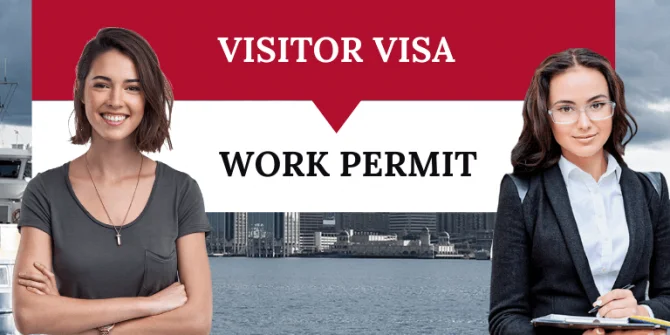Visitor Visa to Work Permit No More: Top 5 Legal Ways to Work in Canada Now

On August 28, 2024, Canada officially ended its Visitor Visa to Work Permit policy, leaving many potential immigrants wondering what’s next. This policy change has been a major shake-up, affecting both those already in Canada on a visitor visa and those planning to come to Canada with hopes of converting their visa status. But don’t lose hope—while this pathway is closing, there are still several legitimate options to consider if you want to work in Canada legally. Here are five key alternatives to the visitor visa to work permit pathway that you should explore right away.
1. Study Permits: A Pathway to Work and Permanent Residency
If you’re in Canada on a visitor visa and your goal is to work, consider switching to a study permit. Why? Studying in Canada not only allows you to work part-time during your studies but also gives you access to the Post-Graduation Work Permit (PGWP). This option lets you work full-time after graduation, opening a path to permanent residency.
How to Get Started:
- Step 1: Visit local colleges and universities to explore available study programs.
- Step 2: Apply to a Designated Learning Institution (DLI) in Canada.
- Step 3: Meet the eligibility criteria, such as having enough funds for tuition and living expenses.
Once you have your study permit, you can legally work part-time while studying and full-time during breaks. After completing your program, apply for a PGWP to gain valuable Canadian work experience, which can eventually lead to permanent residency.
Important Tip: Remember that you need to extend your visitor visa or switch to a study permit within six months of your current visa’s validity to maintain legal status in Canada. Click here for a our step by step video tutorial on how to get a study permit
2. LMIA-Based Work Permits: Applying From Outside Canada
With the visitor visa to work permit pathway closed, you can still apply for a work permit from outside Canada if you have a legitimate job offer supported by a positive Labor Market Impact Assessment (LMIA). While this process can be challenging, it is a direct way to work legally in Canada if you meet the requirements.
Action Steps:
- Secure a Job Offer: Reach out to Canadian employers and apply for jobs that are eligible for LMIA.
- Employer Applies for an LMIA: The employer must prove that no Canadian worker is available to fill the position.
- Apply for a Work Permit: Once the LMIA is approved, submit your work permit application from your home country.
Warning: Be cautious about job offers and agents claiming to provide LMIAs for a fee, as some LMIAs being sold are fraudulent and could jeopardize your future immigration prospects. Click here for our step by step guide on how to get legitimate Jobs in Canada and secure your Canada work permit
3. Provincial Nominee Programs (PNPs): Explore Options Across Canada
If you are in Canada on a visitor visa, another viable option is to explore the Provincial Nominee Programs (PNPs). Many provinces have streams that allow you to apply for a work permit or permanent residency directly if you meet their criteria.
Examples of PNPs You Can Consider:
- Programs for International Graduates: Some provinces prioritize international students who have graduated from their institutions.
- Job Offer-Based Streams: If you have a job offer from an employer in a specific province, you can apply under the PNP stream of that province.
- Specialized Streams for Workers: Programs like the Atlantic Immigration Program (AIP) and the Rural and Northern Immigration Pilot (RNIP) focus on attracting skilled workers to smaller communities.
Research the requirements for each province, including language proficiency, education, and job experience, and consider moving to a province that offers better opportunities for your profile.
Pro Tip: If you decide to switch provinces, ensure that you meet the eligibility requirements of the new PNP stream and apply before your current visa status expires. Learn how to get a provinvial nomination using our express entry masterclass.
4. Marry a Canadian Citizen or Permanent Resident: Spousal Sponsorship
If you are engaged or in a relationship with a Canadian citizen or permanent resident, now might be the time to consider formalizing your relationship. As a spouse, you can apply for a spousal open work permit, which will allow you to work for any employer in Canada.
Eligibility Requirements:
- You must be legally married or in a common-law relationship with a Canadian citizen or permanent resident.
- Proof of relationship is required, such as joint bank accounts, lease agreements, and photos.
While this option won’t apply to everyone, it is one of the easiest and most direct ways to get a work permit and eventually settle in Canada permanently.
5. Staying Informed and Exploring Other Visa Options
Canada’s immigration landscape is constantly changing. With the recent termination of the visitor visa to work permit pathway, the best action is to stay informed and explore other visa categories that match your profile. This includes:
- Returning to Your Home Country: Apply for a work permit from outside Canada if you have a job offer.
- Deferring Your Travel: If your visitor visa is still valid, consider holding off on travel until you have a clearer pathway.
- Caregiver Program: Keep an eye on updates for programs like the Caregiver Program, which requires training and work experience but offers a pathway to a work permit.
Final Advice: Stay on the side of the law at all times. Avoid overstaying your visa or attempting to work illegally, as this could have serious consequences for your future immigration prospects.
Planning Your Next Move in Canada
While the Visitor Visa to Work Permit pathway may be gone, your dream of working in Canada doesn’t have to end here. By exploring the right alternatives—whether through study permits, PNPs, or family sponsorships—you can still find a way to achieve your goals. The key is to act quickly, stay informed, and plan strategically.
Need Personalized Guidance?
Consider booking a consultation for tailored advice based on your situation. Stay positive and proactive—there’s always another path forward!






